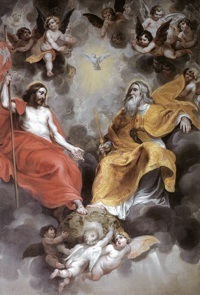[This is a part of the Fundamentals of Effective Catechesis series]
When is the Christian religion not centered on Christ?
Is that possible?
In the last several posts, you’ve seen that the mystery of Christ is the central, organizing theme of catechesis.
This central mystery, which comes from St. Paul himself, connects all of the Catholic Faith into a unified whole.
But, there’s one more aspect you need to understand about really making this central theme work.
Christ is not the only one at the center of the mystery. There is another.
The revelation of the Father
Jesus Christ is the center of the Christian mystery because he’s the one that came and talked to us. But his very message leads us to someone else.
Jesus continually referred to his Father, who sent him, and to the Holy Spirit, who would come after him.
Jesus is like the messenger. He came to reveal the inner life and love of the Father that was completely unknown. He’s also our leader. He forged a path for mankind to journey back to the Father and made it possible for us to follow.
Christ is the “Way” who reveals and leads us into the innermost union of the Father, Son and Holy Spirit–the Blessed Trinity.
The central mystery of the Faith
The Catechism of the Catholic Church #234 says, “The mystery of the Most Holy Trinity is the central mystery of Christian faith and life. It is the mystery of God in himself. It is therefore the source of all other mysteries of faith…” (emphasis added).
It goes on to say, “The whole history of salvation is identical with the history of the way and the means by which the one true God, Father, Son, and Holy Spirit, reveals himself to men ‘and reconciles and unites with himself those who turn away from sin.'”
The mystery of Christ is the history of salvation with Christ at it’s center. However, the essence of Christ’s teaching is the revelation of his own union in the Trinity.
When you see Christ, you see the Father. Essentially, all of Christ’s actions are the actions of the Blessed Trinity in human form. Jesus, in his own life and catechesis, reveals the intimate inner life of God.
But actually, all of salvation history reveals the inner life of God as well. What God does reveals who he is in his innermost being. Persons reveal who they are by their actions. If you’re a generous person, that will come out over time. If you’re a selfish person, your friends will come to know that about you if they spend enough time with you.
So, we come to understand God completely by looking at what he’s done in human history. And, with God what you see is what you get because he doesn’t hold anything back. So, the mystery of Christ, as revealed in the Bible, is like the personal diary of God.
Trinitarian Christocentricity
So, you can see how a Christ-centered message, by it’s very nature leads to faith in the Trinity.
Jesus speaks of he and the Father as the two poles of Christian faith in John 17:3, “And this is eternal life, that they know you the only true God, and Jesus Christ whom you have sent.”
Our message must be both Trinity-centered and Christ-centered–a Trinitarian Christocentricity. It is centered in Christ as the way to communion with the Trinity.
Catechetical takeaway
In essence our faith is about being inserted into the Trinity. But Christ is like our gateway into Trinitarian union. He is the insertion point. We can’t get there unless we are united to him.
You see this reflected in the liturgy as well. Every prayer is offered to the Father, through Christ, in the Holy Spirit. That is the Christians movement toward God.
By understanding this Trinitarian Christocentricity, you can clearly see the essential aspects the Catholic Faith and what needs to be taught. Also, this is what you should go back to again and again as the core beliefs to ingrain in your students.
- Was this helpful for you?
- Did you understand the concepts of a Christ-centered, Trinity-centered central theme?
- If you have any questions, ask them in the comments.
If you like this post, make sure you check out the other parts of the series. This is the fifth installment of Fundamentals of Effective Catechesis. Here I’m laying out the very effective system of catechesis I learned at Franciscan University of Steubenville.


Interesting, Marc, and very true. I recently heard someone remark that one of the problems with most of the guided meditations out there is that most of the time you meet Christ, but then you go back – when in reality, He should lead you to the Father as the true “climactic moment” of the meditation.
That’s a great insight!
I’ve never thought about a meditation that way but it makes perfect sense. I think we often don’t understand or think about relationship with the Father do we? I generally only consider Jesus. However, I had a professor that continually talked about having a close relationship with God the Father. It was always an interesting perspective because no one else talks that way.
Marc,
This is a great post! You’ve said it very well!!!!! May Christ continue to bless you!